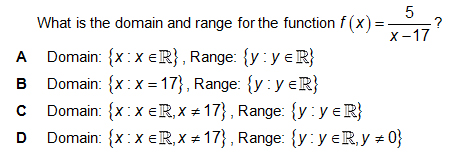Which of the following functions does not have a domain of all real numbers?
A
Correct! The square root function has a domain restriction, since you cannot take the square root of a negative number.
B
Incorrect. This is a linear function, and linear functions do not have domain restrictions.
C
Incorrect. This is an exponential function, and exponential functions do not have domain restrictions.
D
Incorrect. This is a quadratic function, and quadratic functions do not have domain restrictions.

A
Incorrect. The denominator of a rational function cannot be equal to zero.
B
Incorrect. The denominator of a rational function cannot be equal to zero.
C
Incorrect. Rational functions have a horizontal asymptote.
D
Correct!

A
Incorrect. This is set notation for all real numbers.
B
Incorrect. This is interval notation.
C
Correct! The domain of this exponential function is all real numbers.
D
Incorrect. This is inequality notation.
What is the domain and range of the function g(x) = √2x − 8?
A
Incorrect. The ordered pair (4, 0) is also a point included in g(x).
B
Incorrect. The range is also restricted because of the domain restrictions of the square root function.
C
Incorrect. The range is also restricted because of the domain restrictions of the square root function.
D
Correct!